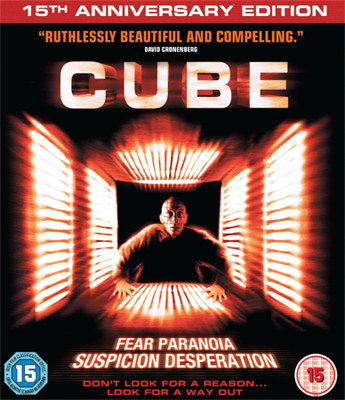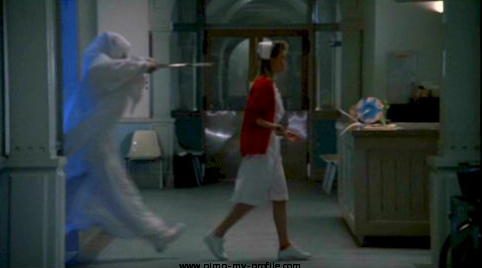Cube (2021)
Directed by: Yasuhiko Shimizu
Written by: Koji Tokuo
Starring: Anne Watanabe, Hikaru Tashiro, Masaki Okuda, Masaki Suda, Takumi Saito

CUBE (2021)
Japanese Language with English Subtitles
CUBE streams on SCREAMBOX from 11th April 2023.
Runtime: 108 mins
Reviewed by Alasdair Yule
**This review will contain spoilers**
I was really looking forward to the Japanese remake of 1997’s CUBE. I really was. But once it was all over, and the credits were rolling, I had to think to myself and consider where it all fell apart. And it fell apart, like Season 8 of Game of Thrones (ok, not quite that bad!) There’s no one thing wrong with the Japanese remake, but rather a large number of little things that all add up to one underwhelming experience.
The set-design is simple but effective. And a noticeable improvement on the original. There’s a room, all walls, floor and ceiling are of equal width, height and breadth. In the centre of each wall, ceiling and floor is a hatch leading to an identical room. And in those rooms are further hatches leading to even more rooms, (this is where I risk turning this explanation into Robin Williams’s Scottish Golf sketch) ‘So’, you may ask, ‘it’s just rooms, rooms and rooms. Keep going and you’ll get out?’ “Hell no,” I shout Scottishly, “there’s 17,577 rrrooms”. ‘But I can use the numbers code to work a way out?’ “Hell no, some of the rooms are trrrapped!”. ‘Ok, but there’s a clear route of safe rooms to the exit?’ “Hell no, the rooms all move around, like a Rubiks Cube off its nut on LSD.” ‘Ok, but access to the exit is always available?’ “Hell no, the rooms are on a timerrrr an’ yeh can only access the exit when the right room is in the right position.”
Essentially, I always thought 1997’s Cube was the cheapest film to make. It can be shot on a shoestring budget – pun intended, we’ll get there! It essentially functions like a stage play, you only need the one set and camera trickery can account for the other rooms. In the remake, as with the original, each room is differentiated with different lighting. As Red Dwarfs Kryton would say, “It means changing the bulb!” Simplicity aside, the “Cube rooms” in the remake are a step up form the original. There’s more symmetry and, on each of the panels, the metal itself has a fractal design on it that looks very good. They nailed the design of the Cube Rooms.
Our characters navigate by tricking the traps into revealing themselves by throwing a boot ahead of them. The boot is tethered to a long rope of tied-together shoe strings (told ya) which is then pulled back for later re-use. A good idea originating from the originals “Wren” character, an escape artist. Trapped rooms claims some of the boots, with spikes and fire, and there are a total of ten boots(twelve if our characters had the presence of mind to salvage those form the body they found).
In these movies, there is always the chance for new writers to be creative with their traps, just like the Saw movie series. And there are new traps in this film, and a couple classics. We have the initial flamethrower that burns boot one. Boot two gets stabbed by innumerable spears that shoot out in all directions. The CGI is a bit dodgy here, but the sound effects pack enough wollop to effectively cover this up and deliver the punch the scene needs.
One trap near the end really got my goat up. It is established that the traps within the rooms can only affect the confines of the room it is in, and the inhabitants therein. A fact that was clearly demonstrated throughout the film and specifically with a sound activated razor-saw-wire trap. Near the end, a massive spear skewers Shinji Ochi, played by Masaki Okada, from another room! Spikes then emerge from his limbs, showing the spear has further spikes within. More of these spears seek to skewer our protagonists who manage to escape. A trap that kills people from other rooms was a clear break of the established rules. This places the protagonists survival as more luck than ingenuity.
In one room, our main character has his brain scanned and the room projects a holographic representation of his memories, specifically those relating to his brother’s suicide. The images are, hilariously, not from the main characters perspective, but from that of a camera man who presumably was there on the day the tragedy happened and chose not to interfere. This room is not a trap as such, just a re-traumatising nuisance. It also annoyed me on the level that this technology, if it is ever realised, is so far in the future that it singularly reframes Cube from being a contemporary horror to sci-fi.
Another thorn in my handsome side was the flashbacks. So, our main character, Yuichi Goto, played by Masaki Suda, has unresolved trauma in his life. His younger brother, as stated, committed suicide. One of the main appeals of the original Cube film was that the experience is meant to be one of endurance, like 2019’s The Lighthouse with Willem Dafoe and Robert Pattinson. The original Cube is an ordeal. And a key ingredient of Cube’s ordeal is claustrophobia. We, the audience, are supposed to feel as encumbered, limited and trapped as our characters. And there is no clear way to escape that intrusive feeling. The original film had me feeling the characters discomfort alongside their fight for survival. The seriousness of the matter of suicide also evaporates some of the “fun”. This is a very heavy topic for what should be a “death-trap romp”! In the Japanese remake, the all-too-frequent flashbacks puncture that claustrophobia and eliminates one of the key sources of tension in the film. I know why it’s there, setup and payoff, but I simply cannot help but feel this is wrong for a Cube film. The Cube itself, the rat-maze the characters are trapped within should hold centre stage to the trauma experienced by the protagonists. Diminishing the Cube literally diminishes the point of the movie. There was something the screenwriter wanted to say, and that in and of itself I do not begrudge, but Cube was the wrong vehicle for that message.
Anne Watanabe plays the character of Asako Kai, who it-bloody-well-transpires, is a Gynoid (female-android, see my review of Megan), this information is revealed right at the very end of the film. During the film she behaves very very robot-like. I have to say that for the length of this film, I thought she was just a bad actress with an inexplicable inability to emote to any degree. Now that I see this was by creative design rather than terrible acting, it has softened my opinion toward the actress, but hardened it against the screenwriter. Why, exactly does this film need a robot? The Cube puzzle traumatises its inhabitants and here we have one less inhabitant to get traumatised by the Cube. I do hope folk know that Anne Watanabe was supposed to be excruciatingly boring in this film and that it does not cost her further acting roles.
Directorial choices. The original film opened with an eye blinking awake. This eye belongs to a character who goes from one room and into an adjacent room. A trap springs and he is diced into little, well, cubes. In the Japanese remake, the shot of the eye slowly opening is of our main character, Shinji Ochi. A better directorial choice, I would say. The Japanese remake gives our teaser character a slightly better Cube themed death, metal shafts spring out from the wall and one claims a large square in his chest, which then falls out and, right before he collapses, his square wound perfectly frames a square wall-light behind him. I thought this is it, boom, opening titles, just like in the original. But no, all our characters get introduced first and then we get the opening titles. They missed a trick there, misplacing the titles. With every X-Files episode you get what is called the teaser, before the opening credits. The teaser gives us a hint of the weirdness Mulder and Scully will soon be investigating. The teaser was pulled off perfectly in the original, but why not here? Well, we now come back to our resident Cube gynoid. And, for further explanation, I had to watch this a second time before fitting these pieces together; the horror franchise, the only genre as far as I can tell, can execute an element of circular storytelling. I’ll give an example, 1987s Hellraiser, Clive Barker’s classic opens on a shady figure, selling a cube (thought I’d keep it relevant) to an equally shady figure sat opposite. “What’s your pleasure sir?” Then we have the delight that is the original Hellraiser story, which then ends with that same shady figure selling that same cube to another shady figure. “What’s your pleasure sir”. The film opens, and ends on that same line of dialogue. Hell, if it’s ADR, it could even be the same recording! Back to the Japanese remake of Cube, the gynoid opens a hatch and introduces herself, then at the very end of the film, she opens another hatch, similarly shot and framed, and introduces herself again. Bam, end credits. I think there were other ways to do this outside introducing a machine character who functionally does nothing but looks bored the entire time. This circular style in horror films, where the horror keeps going at the end, our hero’s having failed to defeat it ultimately, doesn’t need to be here for Cube as the maze structure is still standing at the end of the film with the heavy implication being that other hapless victims will be thrown into it. What bugged me is that it retro-actively undermines the opening credits. A high-price to pay for a setting where the atmosphere almost sells itself.
I always thought that the original Cube had a very made-for-tv feel to it, but dammit, that film did what it set out to do. The Japanese remake, though far more cinematic looking, did not!
Rating: 












Be the first to comment